Successful garage soap making requires precise climate control. You'll need to maintain temperatures between 60-70°F and humidity levels of 30-50% for ideal curing. Use thermohygrometers to monitor conditions, position curing racks away from heat sources, and employ fans for proper air circulation. Consider space heaters in winter and dehumidifiers in summer. Adjust your recipes seasonally—using less water during humid periods and adding sodium lactate for easier unmolding. The right environmental balance transforms your soap from good to exceptional.
Understanding Climate Challenges for Garage Soap Making
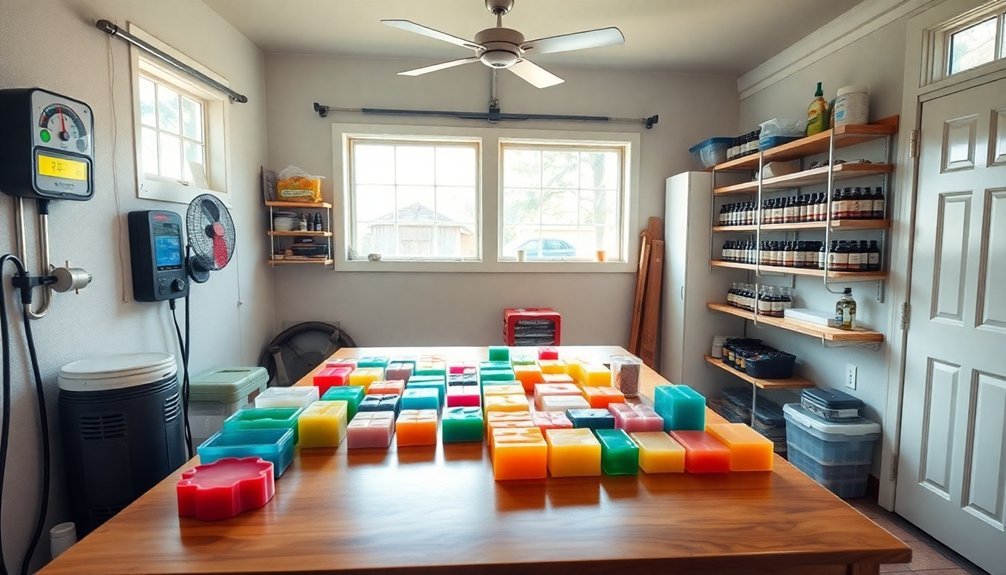
While many soap makers focus on perfecting their recipes, the environment in which you create your soaps plays an equally essential role in determining product quality. Your garage's temperature fluctuations directly impact soap consistency—higher temperatures accelerate saponification, creating thicker mixtures that are harder to work with.
Humidity presents another significant challenge, affecting water evaporation during curing and making unmolding difficult. You'll notice seasonal changes require different approaches; summer's heat melts butters too quickly while winter's chill solidifies oils prematurely. In one documented case, a soap maker had to use air conditioning when room temperature reached 85 degrees Fahrenheit, successfully lowering it to 81 degrees for better consistency.
Tame the seasons or they'll tame your soap—humidity and temperature dictate your craft's success.
Air circulation is important for removing lye fumes and preventing overheating. Without proper ventilation, your soap may develop unwanted textures or glycerin dew.
Using temperature gauges, dehumidifiers, and electric fans will help you maintain ideal conditions year-round, ensuring consistent batches regardless of outdoor weather.
Essential Temperature Control Methods for Optimal Curing
Temperature control serves as the foundation for successful soap curing in your garage workspace. To achieve optimal results, maintain a stable environment between 60-70°F (15-21°C), which prevents excessive moisture absorption while facilitating proper hardening.
You'll need reliable monitoring equipment like thermohygrometers to track both temperature and humidity levels throughout the 4-6 week curing process. Minimize fluctuations by positioning your curing racks away from direct heat sources, drafts, and windows that might cause sudden changes.
Proper ventilation is essential—install small fans to guarantee air circulation without creating temperature inconsistencies. Understanding that hard oils and butters typically require higher temperatures, using the heat transfer method can help achieve consistent results even in variable garage conditions.
During extreme seasons, consider using space heaters in winter or dehumidifiers in summer to maintain your ideal curing climate. These simple adjustments will greatly improve your soap's quality and consistency.
Managing Humidity Levels in Your Garage Workshop
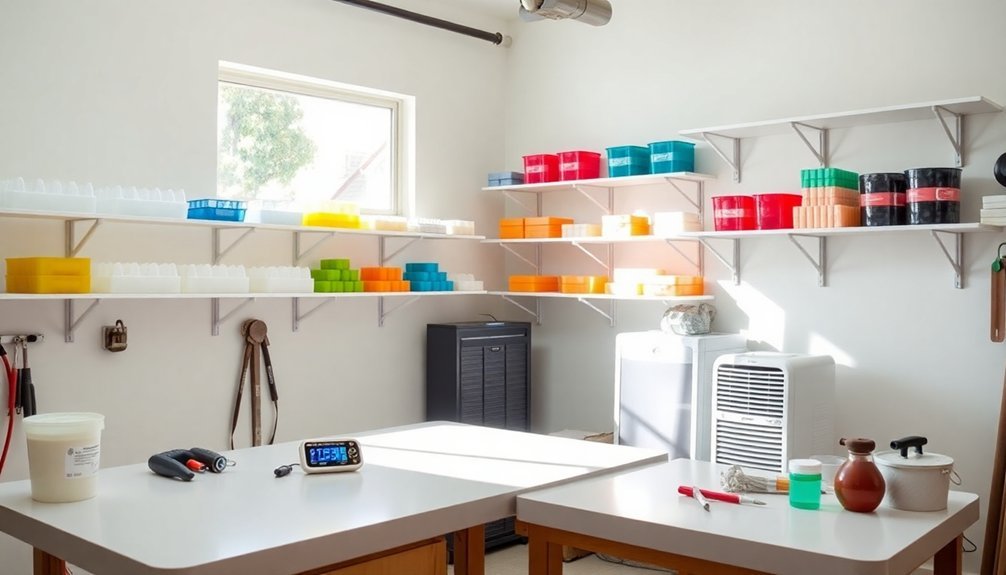
Despite careful temperature regulation, humidity remains the silent challenger that can undermine your soap-making efforts. Moisture levels between 30-50% create ideal curing conditions, but excessive humidity causes soap to sweat as glycerin attracts water from the air.
You'll need a dehumidifier in most climates—especially tropical regions where ventilation alone won't suffice. Monitor conditions regularly with a hygrometer, ensuring you're maintaining consistent levels.
Position soap on well-ventilated racks like metal shelving or milk crates that allow airflow around each bar. The proper air circulation around your soap is essential for the 4 to 6 week curing process to be effective. Insulate your garage properly and seal gaps to prevent moisture infiltration.
For long-term storage, consider shrink-wrapping or biodegradable packaging. If you're in a particularly humid environment, adjust your formulations to include less water content, which reduces curing time and minimizes humidity-related issues.
Effective Ventilation Strategies for Soap Curing
Beyond controlling humidity levels, proper air circulation forms the backbone of successful soap curing in your garage workshop.
Position your curing racks away from direct sunlight while ensuring maximum airflow around each bar. Metal grids or baker's racks work exceptionally well for this purpose.
For garage environments, supplement natural ventilation by cracking doors or using electric fans to boost air movement. Ensure your racks are made of coated metal to prevent rust that could contaminate your soap during curing.
If your garage gets dusty, cover your soap with fine mesh that protects while maintaining circulation. During hot months, consider running a dehumidifier or air conditioner to create ideal curing conditions.
Don't stack soap bars too closely—leave gaps between them so air can freely circulate.
Monitor your soap's progress by weighing bars periodically; consistent weight loss indicates proper curing is occurring.
Seasonal Adjustments for Year-Round Soap Production
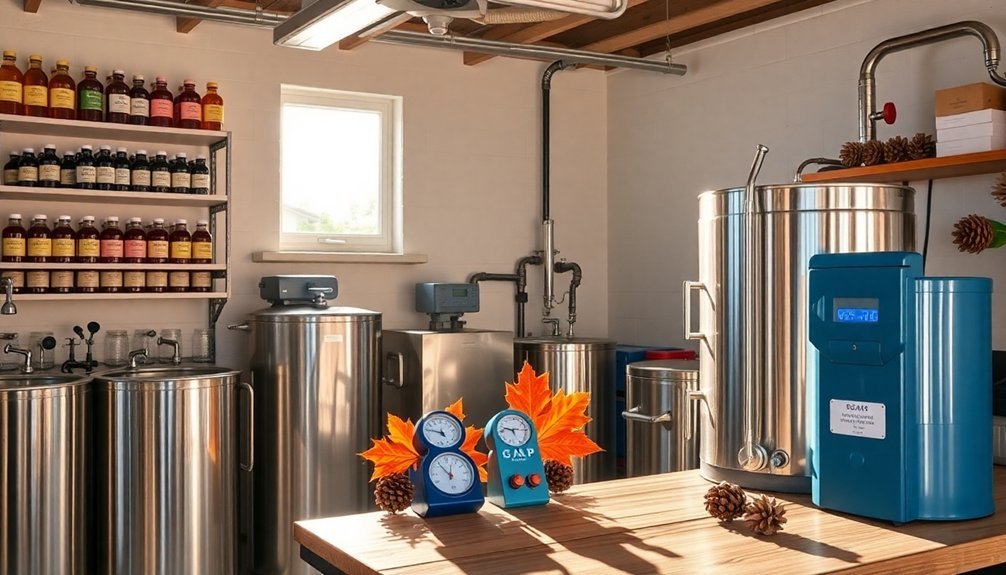
Successful soap makers must adapt their techniques as seasons change to maintain consistent quality throughout the year.
Your temperature management strategy should evolve with each season—insulate well in winter, monitor carefully in summer to prevent overheating. The gel phase, which creates vibrant colors, requires different handling across seasons. Consider monitoring your soap after insulation to check for warmth and a gelatinous appearance which indicates proper gelling.
- Winter Challenge – Create a simple insulation system using towels and cardboard boxes to maintain proper saponification temperatures.
- Summer Vigilance – Check soaps frequently during hot months to prevent the dreaded "alien brains" effect from excessive heat.
- Humidity Battles – Add sodium lactate to recipes during humid months to improve unmolding success.
- Ingredient Adaptation – Store butters and oils appropriately for each season to maintain consistent melting points.
Equipment and Tools for Monitoring Environmental Conditions
Precision instruments form the backbone of effective garage soap making operations.
You'll need thermometers to measure ambient temperature accurately while heat sources and cooling systems help maintain ideal conditions. Energy-efficient designs incorporating heat recovery systems can significantly reduce power consumption and environmental impact. Don't overlook thermal insulation materials to stabilize temperatures during the production process.
For humidity control, invest in a reliable hygrometer to monitor moisture levels. Pair this with dehumidifiers for damp environments or humidifiers for overly dry conditions.
Proper lighting is essential—consider energy-efficient LEDs and strategically positioned task lighting to reduce eye strain.
Ensure adequate ventilation with exhaust fans and air purifiers to remove potentially harmful fumes.
Complete your setup with quality control equipment like pH meters to test soap alkalinity and protective gear to safeguard yourself during the soap-making process.
Troubleshooting Common Climate-Related Soap Making Issues
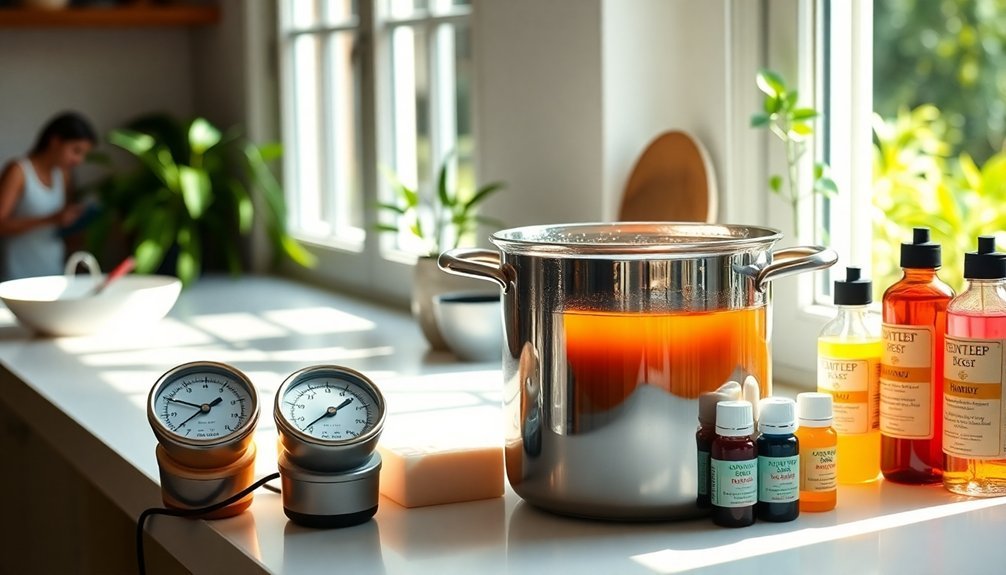
When climate conditions in your garage workspace deviate from ideal ranges, your soap can develop frustrating defects that compromise quality and appearance. You'll need to quickly identify and address these issues to salvage your batch.
Environmental challenges can sabotage your soap's quality, requiring swift action to rescue affected batches.
- Glycerin rivers or "alien brains" – If your soap overheats above 130°F, reduce temperature by moving to a cooler space or using a fan to circulate air.
- Soda ash formation – This powdery white surface appears in cold, dry conditions. Cover fresh soap with plastic wrap to minimize exposure to air.
- Soft, slow-setting soap – High humidity delays hardening. Increase ventilation and consider dehumidifiers during the curing process. Implementing circular economy principles in your workspace can also improve sustainability while managing climate conditions.
- Soap volcanoes – When fragrance oils trigger overheating, use pre-cooled lye solution and monitor temperatures closely throughout the process.
Frequently Asked Questions
How Does Soap Making Affect My Garage's Overall Air Quality?
Soap making releases VOCs and particulate matter into your garage's air, potentially worsening respiratory issues. Without proper ventilation, these chemicals accumulate, degrading air quality and creating health hazards in your workspace.
Can I Cure Soap in My Garage if I Park Cars There?
You can cure soap in your garage with parked cars, but be aware that vehicles cause temperature fluctuations and humidity changes. Use elevated racks and consider a dehumidifier to maintain proper curing conditions.
Will Soap Making Odors Attract Pests to My Garage?
Yes, soap making odors can attract pests. Fragrance oils and raw materials might draw mice, rats, and insects to your garage. Guarantee proper ventilation, sealed storage, and regular cleaning to minimize pest problems.
How Does Altitude Affect Soap Curing in Garage Environments?
At higher altitudes, your soap will cure faster due to lower humidity and air pressure. You'll need better climate control in your garage, including proper ventilation and potentially humidifiers to prevent overly rapid drying.
Is It Safe to Run Dehumidifiers Continuously During Soap Curing?
Yes, you can safely run dehumidifiers continuously during soap curing if you maintain them properly. Just remember to clean filters regularly, monitor humidity levels (aim for 40-50%), and guarantee the water tank doesn't overflow.
In Summary
You've now mastered the climate control essentials for successful garage soap making. By maintaining proper temperature, humidity, and ventilation, you'll avoid common pitfalls and produce consistent, high-quality soap year-round. Monitor your environment closely, make seasonal adjustments as needed, and don't hesitate to troubleshoot when issues arise. With these skills, your garage workshop will become a reliable space for your soap making passion.

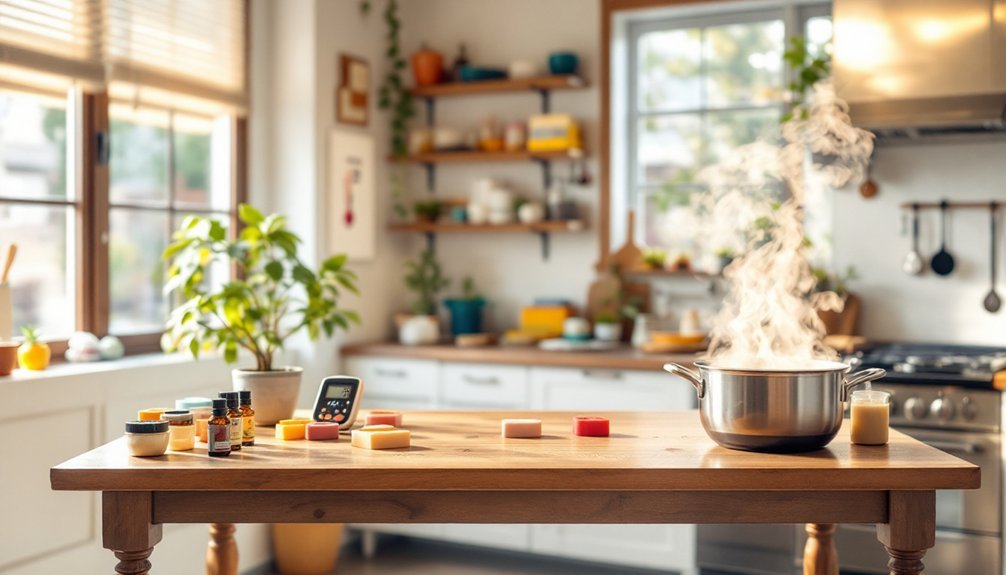



Leave a Reply